MAVEN at BU
The Mission
Boston University’s Center for Space Physics (CSP) announced on 18 September 2008 that it would be participating in NASA’s Mars Atmosphere and Volatile EvolutioN, or MAVEN, mission. The MAVEN spacecraft was first proposed in 2006 to be NASA’s first mission to Mars that was devoted exclusivly to the study of the atmosphere of the red planet. The satellite includes instruments provided by the Laboratory for Atmospheric and Space Physics (LASP) at the University of Colorado Boulder, CO, the Space Science Lab (SSL) at the University of California at Berkeley, CA, and the NASA Goddard Space Flight Center (GSFC) in Greenbelt, MD. Scientists specializing in theory and modeling round our MAVEN Team. Overall responsibility for the mission falls to Professor Bruce Jakosky at LASP.
There is evidence that in the past Mars had an atmosphere with a significantly higher density than found today, and that there was running water on the planet’s surface. No evidence has been found that there is, or was, life on Mars but the conditions required for life were apparently there. The goal of the MAVEN mission is not to search for life but to find out how so much of the atmosphere escaped, leading to a lessening of the greenhouse effect, thereby turning the planet into the frozen world we see today. MAVEN will characterize the current atmosphere and the processes that govern its evolution. This will enable extrapolations into the ancient past to learn how its atmosphere once was — to see if it might have been capable of supporting life as we know it here on Earth. This is a noteworthy and noble goal of solar system exploration.
Important dates for the MAVEN mission
- 18 September 2008: MAVEN is selected, with BU participation
- 18 November 2013: MAVEN launches from Cape Canaveral
- 21 September 2014: MAVEN enters Mars orbit (picture shown below)
- November 2014: Routine science observations started
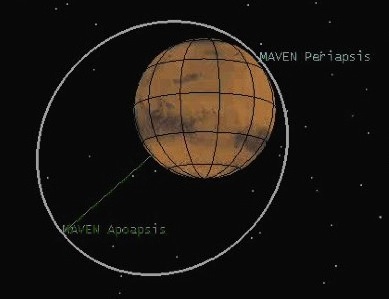
BU’s Participation
Professor John T. Clarke,Director of the Center for Space Physics, was part of the proposing team in 2006, with responsibilities connected to the instrument (an Imaging Ultraviolet Spectrograph, IUVS) being developed at LASP to study the martian atmosphere by using the ultraviolet light it emits. The UVIS performs remote sensing of the vast regions of gas surrounding and escaping from the planet. BU’s role is centered in the echelle spectral channel in the IUVS instrument, which will measure the isotopic ratio of D/H in the martian upper atmosphere. This ratio gives an indication of the total amount of water lost in the history of Mars, since the H atoms escape faster than the heavier D atoms and the ratio will change over time. In 2013, Professor Paul Withers, and Professor Michael Mendillo were selected as Participating Scientists — a category NASA uses to broaden the team of scientists ready to analyze and interpret the flow of data from MAVEN instruments. Professors Withers and Mendillo and their MAVEN teams will work primarily with observations of the martian ionosphere.
There are a number of Postdoctoral researchers, graduate students, and undergraduate students at BU that are working with three faculty teams getting ready to analyze the MAVEN data. Their activities including working on detailed plans for the observing schedules, calibration methods for the UVIS instrument, and readying data analysis methods. In addition, models of the martian upper atmosphere and ionosphere are being developed to understand the interactions between the Sun, Mars and the surrounding environment.
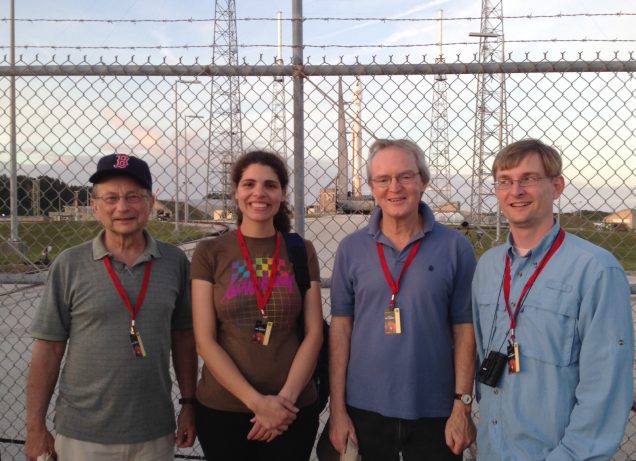
Science Goals
The constituents of the martian atmosphere can be divided into two broad categories: There is an atmosphere composed of neutral gases—both atoms and molecules. Some of these gases are transformed into a plasma (electrically-charged ions and electrons). The BU teams study both forms of atmosphere.
Addressing Neutral Atmosphere Structure and the Direct Escape of Gas.
Professor John T. Clarke and his team are using the IUVS instrument on MAVEN to measure the hydrogen that is escaping from the atmosphere of Mars.
To prepare for the data to come from MAVEN, prior observations using the Hubble Space Telescope (HST) are being analyzed. The left image below was taken in May 2014 with an HST camera equipped with a filter to isolate ultraviolet emissions. The image shows far-UV emission from the disc of Mars, mostly solar continuum scattered in the atmosphere, but in some places part of the spectrum penetrates to the surface allowing surface features to be seen. Imaging processing revealed that most of the UV light from the surface is from wavelengths in the range 170-190 nm. When subtracted from the original data, the final image is shown on the right — revealing Mars’ hydrogen exosphere. This region of escaping hydrogen gas extends to several martian radii above the surface due to the weak gravity of Mars. The study of this ultraviolet signature of an escaping corona of hydrogen gas is one of the major goals of the MAVEN mission.
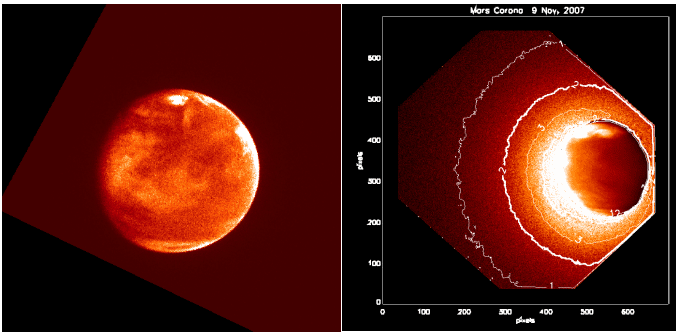
Addressing Ionospheric Structure and Plasma Escape.
Professor Paul Withers and his team plan to use data from multiple instruments to look into how the neutral atmosphere and ionosphere of Mars are affected by one another. The figure below shows two observations of the martian ionosphere made by the Mars Express satellite. Above the main peak of the ionosphere of Mars, electron densities decrease with increasing altitude. In some regions, they decrease rapidly with altitude, but in other regions they decrease more slowly. Changes in this rate of change of electron density probably imply changes in the physical processes that control the vertical distribution and escape of ions and electrons. Professor Withers and his team will be using MAVEN data to explore what determines whether electron densities decrease rapidly or slowly with increasing altitude.
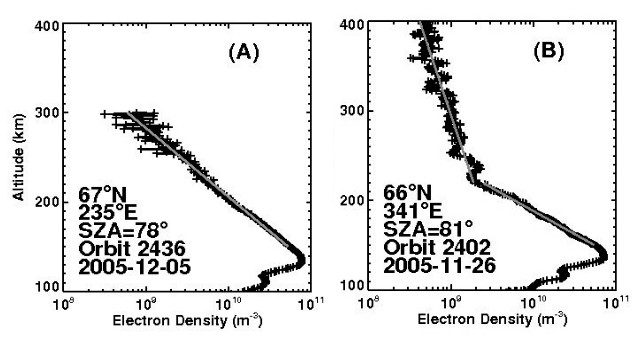
Professor Michael Mendillo and his team will work with MAVEN scientists in areas of modeling the ionosphere. The formulation of a Mars International Reference Ionosphere (MIRI) is an initiative started at Boston University with the aim of providing the MAVEN instrument teams with “prior context” for new observations. The first generation of MIRI uses archived ionospheric data from NASA’s Mars Global Surveyor (MGS) and the European Space Agency’s Mars Express (MEX) missions to set a baseline of information about the martian ionosphere. For a given date, MIRI predicts the electron densities that MAVEN could expect to observe as a function of space, time and solar activity. Once MAVEN establishes a large data set of parameters not measured by MGS or MEX (e.g., the types of ions present and the temperatures of ions and electrons), MIRI will be expanded and upgraded by incorporating the new MAVEN observations into MIRI. The current version of MIRI is an open-access model available at website http://sirius.bu.edu/miri/. The figure below gives MIRI estimates of the electron density values predicted for along the first MAVEN orbit on 4 November 2014.
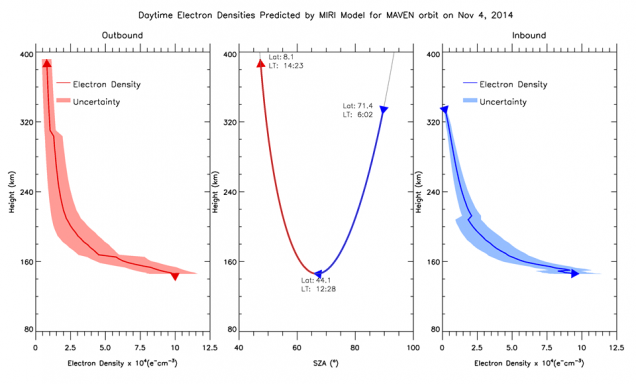

******************************************************************************************
The BU-MAVEN Team Members
(1) The Ultra-Violet Sensor Group:
Professor John Clarke, Co-I on the UVIS instrument
Dr. Majd Mayyasi, Research Scientist
Dolon Bhattacharyya, Postdoctoral Associate
Vidhu Nath, Undergraduate Research Assistant
(2) The Ionospheric Structure Group:
Professor Paul Withers, MAVEN Participating Scientist
Dr. Marissa Vogt, Postdoctoral Fellow
(3) The Mars International Reference Ionosphere Group:
Professor Michael Mendillo, MAVEN Participating Scientist
Ms. Clara Narvaez, Staff Researcher
Mr. Gerard Lawler, Undergraduate Research Assistant
Mr. Jeffrey Trovato, Undergraduate Research Assistant